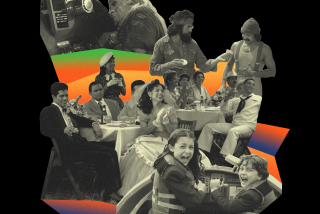Cinco de Mayo--Some Uncommon Heroes for a Day Commemorating Heroism
- Share via
In a recent informal survey I polled 100 Chicanos at Stanford University and 100 Chicano activists from the late 1960s to find out whom they considered the top 13 Chicano heroes.
The idea arose from a mural that I was designing on the mythology and history of maiz (corn). I had intended to depict the Last Supper; Christ and his 12 apostles were to be portrayed dining on tortillas and tamales and tequila instead of bread and wine. I dropped that idea when some students expressed dismay at my mixing humor with religion. That’s when I decided to replace the religious figures with 13 Chicano heroes. (The mural is now in progress in the dining hall of Casa Zapata, the Chicano-theme student residence at Stanford.)
My survey was received positively--there was a 70% return--and also as a novelty.
Essentially, the ultimate 13 Chicano heroes reflected the choice of the older activists because their votes were concentrated on a smaller group of heroes who had played important parts in the Chicano movement as activists or symbolic historical figures. The students were more inclusive, and offered a total of 240 hero candidates.
The selection process brought into question the very definition of a hero or heroine as a mythical, historical, symbolic, military or popular culture figure.
The first historical Chicano hero, according to some, was Gen. Ignacio Zaragoza, born in Seguin, Tex., when Texas was part of Mexico. Zaragoza rose to command the ragtag Mexican army unit that defeated the French in Puebla on Cinco de Mayo , 1862. At that time the French army of Napoleon III was the most powerful in the world. But Zaragoza did not make the final list. One who did was a man who preceded him both in time and in popular lore, the Californio rebel and bandit, Joaquin Murieta.
Three living Chicanos who started their careers together made the list: Cesar Chavez, Dolores Huerta and Luis Valdez.
La Virgen de Guadalupe , patroness of Mexico, received enough votes to sit at the table, but out of respect will instead occupy a loftier place. In a history mobbed with machos , there was a sincere effort to vote not only for women like painter Frida Kahlo and poet Sor Juana Inez de la Cruz but also for mothers and grandmothers.
Not all the heroes had to be Chicano--that is, of Mexican roots; thus Argentine-born Cuban hero Che Guevara made the list. The martyred Che, a strong symbol during the Chicano movement of the late ‘60s, will occupy the central position. At his side will be the Mexican revolutionary, Emiliano Zapata.
Dr. Martin Luther King Jr. was another non-Chicano who made the seating. President John F. Kennedy also got some votes, but not enough to sit at the table. He will be in the background, along with Gen. Zaragoza and others who did not make the final list.
Carlos Santana, who helped revolutionize North American music with Latino sounds, will be painted standing and serenading the chosen 13. Among them are our contemporaries, writers Tomas Rivera and Ernesto Galarza, and a contemporary of Abraham Lincoln, Benito Juarez; also, the revolutionary activist and writer, Ricardo Flores Magon.
Death received enough votes to stand behind the lucky 13. La muerte , so popular in Mexico, is a heroine, a great avenger and savior from la vida.
Humorous characters like Cantinflas and Tin-Tan will also be in the background.
One student voted for Juan Valdez of the television coffee commercial, Jose Cuervo tequila, Speedy Gonzalez, Senor Don Gato, Julio Iglesias, Pedro the Mexican Jumping Bean, Tattoo from “Fantasy Island,” Menudo and Zorro the Gay Blade. This list was at once humorous and revealing about how Latinos are sometimes perceived through stereotypes and media stars.
Chicano heroes have always been an elusive lot. Mexicanos and Chicanos have traditionally frowned on the North American individualism that Alexis de Toqueville remarked on more than a century ago. Latinos are a group-oriented society. Most of Mexico’s national heroes were martyrs, having died in service to the people--from Miguel Hidalgo, father of Mexican independence, who was executed, to revolutionary heroes Francisco Villa and Zapata, who were ambushed and assassinated.
To further illustrate the group orientation of Chicanos, there is an oft-told story that compares Latinos to a bucket of crabs: Supposedly, crabs form a pyramid against the wall of a bucket to escape, but as the top crab reaches the edge and is about to climb out, the other crabs pull it back. While the crab theory doesn’t hold water, it does illustrate the unity and solidity of the Latino community.
In the survey, the group-oriented focus came through time and again in votes for mothers, fathers, grandparents, Vietnam veterans, braceros , campesinos and pachucos. But it was best expressed by one student who chose as his heroes “all the people who died, scrubbed floors, wept and fought so that I could be here at Stanford.”
More to Read
Sign up for Essential California
The most important California stories and recommendations in your inbox every morning.
You may occasionally receive promotional content from the Los Angeles Times.










